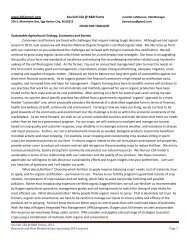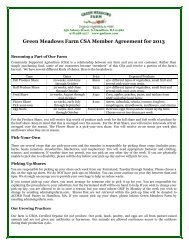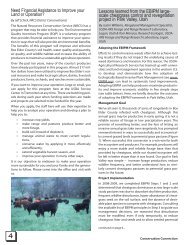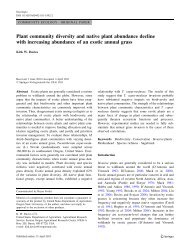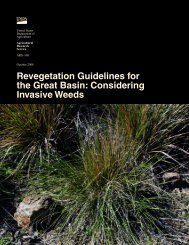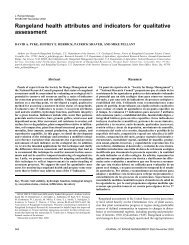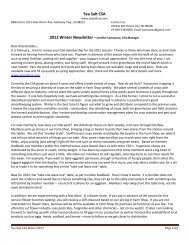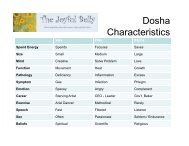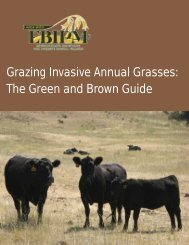Exotic Plant Management in California Annual Grasslands
Exotic Plant Management in California Annual Grasslands
Exotic Plant Management in California Annual Grasslands
You also want an ePaper? Increase the reach of your titles
YUMPU automatically turns print PDFs into web optimized ePapers that Google loves.
FIGURE 22.1 Close-ups of flowerheads of two common <strong>in</strong>vasive Centaurea species <strong>in</strong> <strong>California</strong>.Left: C. melitensis (tocalote or Malta starthistle). Right: C. solstitialis (yellow starthistle). Note that thesp<strong>in</strong>es on C. solstitialis are approximately twice the length of those found on C. melitensis.<strong>in</strong>vasive plants <strong>in</strong> <strong>California</strong>’s valley grasslands, the two mostcommon species are yellow starthistle and medusahead (seeFigures 22.1, 22.2). Downy brome, despite its widespreadwestern impact, has caused significant problems only <strong>in</strong> thenortheastern (Modoc Plateau) part of the state, so it will notbe discussed further here.ImpactsInvasive non-native plants <strong>in</strong> <strong>California</strong> grasslands can havesignificant ecological and economic impacts. Although amore thorough treatment of ecological impacts can be found<strong>in</strong> Chapter 6, a number of key impacts will be discussed here.S<strong>in</strong>ce the <strong>California</strong> grasslands have historically played amajor role <strong>in</strong> livestock production, weed impacts have oftenbeen strongly associated with that <strong>in</strong>dustry. Impacts <strong>in</strong>clude<strong>in</strong>terference with graz<strong>in</strong>g practices; reductions <strong>in</strong> forageproductivity or quality; <strong>in</strong>creased costs of manag<strong>in</strong>g and produc<strong>in</strong>glivestock; reduced animal weight ga<strong>in</strong>s; reduced qualityof meat, milk, wool, and hides; and livestock poison<strong>in</strong>g.Medusahead, for example, is of low value because of its highsilica content (George 1992). This reduces the forage qualityand makes it less palatable to livestock and wildlife comparedto other forage grasses. In areas heavily <strong>in</strong>fested withmedusahead, livestock carry<strong>in</strong>g capacity can be reduced byas much as 75 to 80% (Major et al. 1960; Hironaka 1961;George 1992). One of the more recent animal issues to cometo light is the impact of many <strong>in</strong>vasive plants on the horse<strong>in</strong>dustry, especially where small acreage development isoccurr<strong>in</strong>g. Invasive forbs such as yellow starthistle, Russianknapweed, houndstongue, and tansy ragwort can result <strong>in</strong>poison<strong>in</strong>g and death to horses when consumed at high levels(Cordy 1954).Direct impacts of grassland weeds on humans and qualityof life <strong>in</strong>clude <strong>in</strong>creased allergens <strong>in</strong> the air, sickness ordeath from <strong>in</strong>advertent consumption of poisonous plants,damage to recreational equipment, and <strong>in</strong>jury or discomfortfrom physical contact with sp<strong>in</strong>y thistles such as milk thistleand yellow starthistle or abrasive parts such as the awnsof ripgut brome (Bromus diandrus). With <strong>in</strong>creased use ofgrasslands for recreational activity, <strong>in</strong>clud<strong>in</strong>g hik<strong>in</strong>g andbik<strong>in</strong>g, direct impacts on humans are now much moreprevalent (DiTomaso 2000).In addition to impacts on humans and animals, many <strong>in</strong>vasiveplants may alter ecosystem structure and functionalprocesses, <strong>in</strong>clud<strong>in</strong>g hydrologic, fire, and nutrient cycles. Structuralchanges <strong>in</strong> <strong>in</strong>vaded plant communities typically causereduced native species richness and diversity and changes <strong>in</strong>canopy structure (Belcher and Wilson 1989; Parmenter andMacMahon 1983; Rikard and Cl<strong>in</strong>e 1980; Wallace et al. 1992).In one study reported on by DeLoach (1991), the number ofplant species present <strong>in</strong> <strong>California</strong> grasslands <strong>in</strong>creased by 35%follow<strong>in</strong>g biological control of common St. Johnswort (Hypericumperforatum). When large scale conversions of vegetationallife history strategies and phenology occur, the potential forfunctional changes to hydrology, nutrient, and fire cycles probably<strong>in</strong>creases. This has been observed with the late-matur<strong>in</strong>g,deeply rooted forb yellow starthistle when it <strong>in</strong>vades the earlymatur<strong>in</strong>g,shallow-rooted annual grass communities. Yellowstarthistle has been shown to deplete soil moisture reservesand alter water cycles <strong>in</strong> annual grasslands (Enloe et al. 2005).This could cause large annual economic losses <strong>in</strong> water conservationcosts <strong>in</strong> <strong>California</strong>. In Siskiyou County, for example,it was estimated that the potential water loss due to yellowstarthistle would be more than 100,000 m 3 , or 26,400,000gallons, per year (Enloe 2002). The depletion of soil moistureEXOTIC PLANT MANAGEMENT 283



